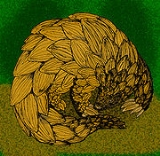
Necromanis
Encyclopedia
Necromanis is an extinct genus
of pangolin
from the Miocene
of France. Necromanis is descended from the Eocene
pangolins of genus Eomanis
.
From what can be derived from the fossil specimens, the species of Necromanis were, for the most part, identical to modern Manis pangolins in anatomy, diet, and behavior.
There are at least three species
recognized.
Genus
In biology, a genus is a low-level taxonomic rank used in the biological classification of living and fossil organisms, which is an example of definition by genus and differentia...
of pangolin
Pangolin
A pangolin , also scaly anteater or Trenggiling, is a mammal of the order Pholidota. There is only one extant family and one genus of pangolins, comprising eight species. There are also a number of extinct taxa. Pangolins have large keratin scales covering their skin and are the only mammals with...
from the Miocene
Miocene
The Miocene is a geological epoch of the Neogene Period and extends from about . The Miocene was named by Sir Charles Lyell. Its name comes from the Greek words and and means "less recent" because it has 18% fewer modern sea invertebrates than the Pliocene. The Miocene follows the Oligocene...
of France. Necromanis is descended from the Eocene
Eocene
The Eocene Epoch, lasting from about 56 to 34 million years ago , is a major division of the geologic timescale and the second epoch of the Paleogene Period in the Cenozoic Era. The Eocene spans the time from the end of the Palaeocene Epoch to the beginning of the Oligocene Epoch. The start of the...
pangolins of genus Eomanis
Eomanis
Eomanis is the earliest known true pangolin from the Middle Eocene of Europe. Fossils collected from the Messel Pit, Germany, indicate that this 50 cm long animal was rather similar to living pangolins. However, unlike modern pangolins, its tail and legs did not bear scales...
.
From what can be derived from the fossil specimens, the species of Necromanis were, for the most part, identical to modern Manis pangolins in anatomy, diet, and behavior.
There are at least three species
Species
In biology, a species is one of the basic units of biological classification and a taxonomic rank. A species is often defined as a group of organisms capable of interbreeding and producing fertile offspring. While in many cases this definition is adequate, more precise or differing measures are...
recognized.

